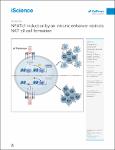NFATc1 induction by an intronic enhancer restricts NKT γδ cell formation
| dc.contributor.author | Giampaolo, S | |
| dc.contributor.author | Chiarolla, CM | |
| dc.contributor.author | Knöpper, K | |
| dc.contributor.author | Vaeth, M | |
| dc.contributor.author | Klein, M | |
| dc.contributor.author | Muhammad, A | |
| dc.contributor.author | Bopp, T | |
| dc.contributor.author | Berberich-Siebelt, F | |
| dc.contributor.author | Patra, AK | |
| dc.contributor.author | Serfling, E | |
| dc.contributor.author | Klein-Hessling, S | |
| dc.date.accessioned | 2023-04-03T11:00:21Z | |
| dc.date.available | 2023-04-03T11:00:21Z | |
| dc.date.issued | 2023-03-17 | |
| dc.identifier.issn | 2589-0042 | |
| dc.identifier.issn | 2589-0042 | |
| dc.identifier.other | 106234 | |
| dc.identifier.uri | https://pearl.plymouth.ac.uk/handle/10026.1/20652 | |
| dc.description.abstract |
In thymus, the ablation of T cell receptor (TCR)-activated transcription factor NFATc1 or its inducible isoforms during the double-negative (DN) stages of thymocyte development leads to a marked increase in γδ thymocytes whereas the development of αβ thymocytes remains mostly unaffected. These γδ thymocytes are characterized by the upregulation of the promyelocytic leukemia zinc-finger factor (PLZF), the "master regulator" of natural killer T (NKT) cell development, and the acquisition of an NKT γδ cell phenotype with higher cell survival rates. The suppressive function of NFATc1 in NKT γδ cell formation critically depends on the remote enhancer E2, which is essential for the inducible expression of NFATc1 directed by its distal promoter P1. Thus, the enhancer deciphers a strong γδ TCR signal into the expression of inducible NFATc1 isoforms resulting in high levels of NFATc1 protein that are essential to control the numbers of NKT γδ cells. | |
| dc.format.extent | 106234-106234 | |
| dc.format.medium | Electronic-eCollection | |
| dc.language | en | |
| dc.publisher | Cell Press | |
| dc.subject | Immunology | |
| dc.subject | developmental biology | |
| dc.subject | molecular biology | |
| dc.title | NFATc1 induction by an intronic enhancer restricts NKT γδ cell formation | |
| dc.type | journal-article | |
| dc.type | Journal Article | |
| plymouth.author-url | https://www.webofscience.com/api/gateway?GWVersion=2&SrcApp=PARTNER_APP&SrcAuth=LinksAMR&KeyUT=WOS:000996440100001&DestLinkType=FullRecord&DestApp=ALL_WOS&UsrCustomerID=11bb513d99f797142bcfeffcc58ea008 | |
| plymouth.issue | 3 | |
| plymouth.volume | 26 | |
| plymouth.publication-status | Published | |
| plymouth.journal | iScience | |
| dc.identifier.doi | 10.1016/j.isci.2023.106234 | |
| plymouth.organisational-group | |Plymouth | |
| plymouth.organisational-group | |Plymouth|Faculty of Health | |
| plymouth.organisational-group | |Plymouth|REF 2021 Researchers by UoA | |
| plymouth.organisational-group | |Plymouth|Users by role | |
| plymouth.organisational-group | |Plymouth|Users by role|Academics | |
| plymouth.organisational-group | |Plymouth|REF 2021 Researchers by UoA|UoA01 Clinical Medicine | |
| plymouth.organisational-group | |Plymouth|Faculty of Health|Peninsula Medical School | |
| dc.publisher.place | United States | |
| dcterms.dateAccepted | 2023-02-13 | |
| dc.date.updated | 2023-04-03T11:00:06Z | |
| dc.rights.embargodate | 2023-4-4 | |
| dc.identifier.eissn | 2589-0042 | |
| dc.rights.embargoperiod | forever | |
| rioxxterms.versionofrecord | 10.1016/j.isci.2023.106234 |


